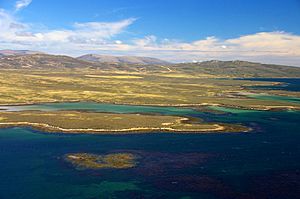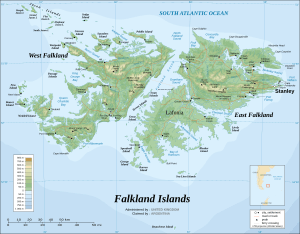West Falkland facts for kids
Quick facts for kids
West Falkland
Isla Gran Malvina (Spanish)
|
|
|---|---|

West Falkland from Keppel Island
|
|

Location of West Falkland (red)
in the Falkland Islands (red & white) |
|
| Location | Atlantic Ocean |
| Archipelago | Falkland Islands |
| Area | |
| • Total | 4,532 km2 (1,750 sq mi) |
| Area rank | 2nd |
| Population
(2016)
|
|
| • Total | 160 |
| • Rank | 2nd |
| • Density | 0.0353/km2 (0.0914/sq mi) |
| Highest elevation | 700 m (2,300 ft) |
| Highest point | Mount Adam |
| Polity | Falkland Islands |
| Largest settlement | Port Howard |
| a. All islands in the Falkland Islands. b. All inhabited islands in the Falkland Islands. |
|
West Falkland (called Isla Gran Malvina in Spanish) is the second largest island in the Falkland Islands. These islands are located in the South Atlantic Ocean. West Falkland is a hilly island. It is separated from East Falkland by a narrow channel of water called the Falkland Sound.
The island covers an area of 4,532 square kilometers (1,750 square miles). This is about 37% of the total land area of the Falkland Islands. Its coastline stretches for 1,258.7 kilometers (782 miles).
People and Settlements
Fewer than 200 people live on West Falkland. They are spread out in small settlements along the coastline. The largest settlement is Port Howard, which is on the east coast. It has its own airstrip.
Other settlements include Albemarle, Chartres, Dunnose Head, Fox Bay, Fox Bay West, Hill Cove, Port Stephens, and Roy Cove. Most of these places are connected by roads. They also have airstrips and small harbors.
The population of West Falkland has changed over time. In 1986, there were 265 people. By 2001, this number had fallen to 144. However, it rose slightly to 160 people in 2016.
Areas outside the main towns of Stanley and RAF Mount Pleasant on East Falkland are called "Camp" by people in the Falkland Islands. West Falkland is considered part of the Camp.
Geography and Wildlife

West Falkland is hillier on the side closest to East Falkland. The main mountain range is called the Hornby Hills. These hills run alongside the Falkland Sound. Mount Adam is the highest hill on the islands. It stands 700 meters (2,300 feet) above sea level.
For a while, people thought Mount Robinson was the highest point at 695 meters (2,280 feet). But a later survey found that Mount Adam was actually taller.
The main industry on the island is sheep farming. West Falkland is also known for its colonies of penguins and cormorants. Fishing is popular in the island's two main rivers, the Warrah and the Chartres.
In the 1800s, there were very few native land animals. A small wolf-like animal called the warrah (also known as the Falkland Islands wolf) used to live here. It is now extinct. The last one was seen around 1875 on West Falkland. Its memory lives on in the name of the Warrah River and the settlement of Fox Bay.
Settlers brought other animals to the island. These included wild herds of cattle and horses, as well as wild hogs, many rabbits, and some hares. Over time, the numbers of these animals have greatly decreased. They have been replaced by sheep, which are more profitable for farming.
The southernmost tip of West Falkland is Cape Meredith. The most south-westerly point is Calm Head. The southern coast has high cliffs where many seabirds live. To the west, you can find white sandy beaches with clear water and rolling sand dunes covered in tall grass. These beaches are home to elephant seals. They are very clean, with only occasional pieces of wreckage or washed-up tree trunks.
Geology
Most of the rock layers on West Falkland and its nearby islands are slightly tilted. This tilt means you can see different types of rocks in different areas. For example, the hard quartzite rocks found near Port Stephens and Stanley are stronger than the sandy rocks found at Fox Bay.
The Hornby Mountains, which are close to Falkland Sound, have been pushed up and folded by strong forces in the Earth. This has caused the quartzite rock layers in that area to stand almost straight up.
West Falkland also has several ancient rock formations called dykes. These dykes cut through the older rocks of the western islands. However, these dykes were made of less stable material and have worn away over time. The only signs they were ever there are long, straight dips in the land. Along the edges of these dips, you can see where the heat from the once-molten rock changed the surrounding rocks.
History
Early explorers reported finding parts of canoes on West Falkland. It is not clear if these canoes were used by people who traveled there or if they simply drifted from Patagonia.
The first recorded landing on either West or East Falkland was made by Captain John Strong in his ship, the Welfare. This happened on January 29, 1690, at Bold Cove, near Port Howard. He wrote about finding fresh water and many geese and ducks. He also noted there was no wood, which is surprising because driftwood often washes ashore. This might be because Bold Cove is a very sheltered spot. Captain Strong named Falkland Sound, which later gave its name to all the islands.
Even though the first recorded landing was on West Falkland, it was settled quite late. In 1867, there were no settlers living there. The government then offered land for sheep grazing at very good prices. By 1868, all the available land was taken by settlers.
Today, West Falkland is home to two RAF Remote Radar Heads. These are radar stations that help with air traffic control and defense. One is at Mount Alice, near Port Albermarle in the south. The other is at Mount Byron in the north.
In early 2007, the Falkland Islands Government started a ferry service between West and East Falkland. This ferry runs between Port Howard and New Haven.
Falklands War
West Falkland saw some action during the Falklands War in 1982. During the conflict, Argentine troops occupied Fox Bay, Port Howard, and Pebble Island. These areas were sometimes attacked by British naval ships and aircraft.
One important fight on West Falkland was the skirmish at Many Branch Point, which happened near Port Howard.
At Shag Cove, several Argentine helicopters were shot down after being attacked by British Harrier jump jets. The raid on Pebble Island is also a famous event in British Special Forces history.
See also
 In Spanish: Isla Gran Malvina para niños
In Spanish: Isla Gran Malvina para niños


